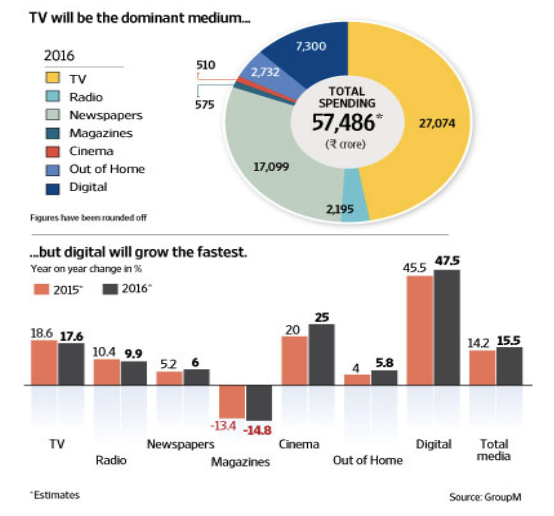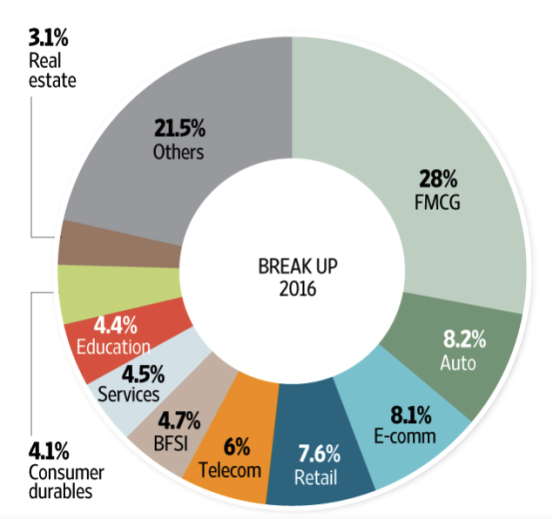Analysis of India’s Advertising Industry
| ✅ Paper Type: Free Essay | ✅ Subject: Marketing |
| ✅ Wordcount: 1231 words | ✅ Published: 07 Sep 2017 |
Indian Advertising Industry:
An Introduction
Introduction
The Indian advertising industry has evolved from being a small-scaled business to a full-fledged industry. The advertising industry is projected to be the second fastest growing advertising market in Asia after China.
It is estimated that by 2018, the share of ad spend in India’s Gross Domestic Product (GDP) will be around 0.45 per cent.
The Indian government has given tremendous support to the advertising and marketing industry. Advertising expenditure is likely to increase in the financial sector, driven by Reserve Bank of India (RBI) policies which could result in a more favourable business environment. Also, proposed licences for new banks and better market sentiments render the advertising and marketing industry in India a fertile space.
Market size
India’s Advertising industry is expected to grow at a rate of 16.8 per cent year-on-year to Rs 51,365 crore (US$ 7.61 billion) in 2016, buoyed by positive industry sentiment and a strong GDP growth of 7 per cent and above.
India’s digital advertising market has grown at a fast pace of 33 per cent annually between 2010 and 2015, while spending as a percentage of total advertising increased to 13 per cent or nearly US$ 1 billion in 2015.
Print contributes a significant portion to the total advertising revenue, accounting for almost 41.2 per cent, whereas TV contributes 38.2 per cent, and digital contributes 11 per cent of the total revenue. Outdoor, Radio and Cinema make up the balance 10%.
Of the current Rs 2,750 crore (US$ 407.66 million) digital advertisement market, search and display contribute the most – search advertisements constitute 38 per cent of total advertisement spends followed by display advertisement at 29 per cent, as per the study.
The Internet’s share in total advertising revenue is anticipated to grow twofold from eight per cent in 2013 to 16 per cent in 2018. Online advertising, which was estimated at Rs 2,900 crore (US$ 429.9 million) in 2013, could jump threefold to Rs 10,000 crore (US$ 1.48 billion) in five years, increasing at a compound annual rate of 28 per cent
Advertising agencies in the country too have taken a leap. They have come a long way from being small and medium sized industries to becoming well known brands in the business. Mudra,OgilvyandMathew(O&M),McCannEricsonn,Rediffussion,LeoBurnettare some of the top agencies of the country.
Indian economy is on a boom and the market is on a continuous trail of expansion. With the market gaining grounds Indian advertising has every reason to celebrate. Businesses are looking up to advertising as a tool to cash in on lucrative business opportunities. Growth in business has lead to a consecutive boom in the advertising industry as well.
The Indian advertising today handles both national and international projects. This is primarily because of the reason that the industry offers a host of functions to its clients that include everything from start to finish that include client servicing, media planning, media buying, creative conceptualization, pre and post campaign analysis, market research, marketing, branding, and public relation services.
Keeping in mind the current pace at which the Indian advertising industry is moving the industry is expected to witness a major boom in the times ahead. If the experts are to be believed then the industry in the coming times will form a major contribution to the GDP. With al this there is definitely no looking back for the Indian advertising industry that is all set to win accolades from the world over.
Advertisement Spending Sector Wise

Advertisement Spending Sector Wise

Introduction
The issue of TV advertising and children has always been quite controversial. In past hundreds of studies have been conducted on this topic. Some of these studies are based on the observation of children in experimental situations. By their use of a non-verbal research method, these studies have the advantage of avoiding misrepresentation caused by some children’s verbal skills whenresponding to verbal tests. The disadvantage of this type of experimental research,however, is that the real-life validity of the results is sometimes quite low.
Similarly, research data based on the actual questioning of children should be treated with caution, since younger children especially misunderstand the questions, lack the verbal techniques to provide an adequate answer, or are simply intimidated by the presence of the researcher.
In this study, I chose a third method: to obtain evidence related to TV advertising and children by questioning children’s parents. Parental attitudes towards the issue of TV advertising and children are of utmost importance to this issue, given the role played by the parents in a great many aspects of their children’s lives.
LITERATURE SURVEY
The marketers and advertisers have shown keen interest on the market segment of children’s product and services; conducted surveys on children television advertising containing trade publications. Involvement of Academicians on the research studies of children research during the period of 1980 was reduced to the amount of publication on the products of children.1 A little publication was done to the children’s television. Investigation had showed that animation which was used to the adult target audience, now using for the children programming especially in the commercials for games, toys, candies, cereals, etc.
A study on the content analysis of television advertising of today children has focused on the change or growth in presentation of advertisements over the period.
The findings concluded in the study were as:
- The male voice-over is still predominant in advertising 32
- The advertisement which has focused on personal gain to fun and happiness of children, now focused on children’s product performance.
In the study conducted on evaluation of research pertaining to children and advertising by Jeffry Gold Slain in four countries namely Sweden, Belgium, Netherlands and Britain; found little evidence to supporting the position that the children are vulnerable to advertising. He opined that the influence of mass media is more on children than on parents and playmates. The argument is that the commercial advertisement creates wants in children and bring pester power on their parents for the products advertisement. In fact, the parents succumb to their children’s demands assuming to be true despite paucity of support evidence. Jeffry Gold Slain believes that the influence of children has come by the advertisers from so many directions which have no critical examination.
The Task-force of the American Psychological Association had conducted a study on children and observed that children under the age of 8 years are unable to comprehend critically the televised advertising messages and are prone to accept the advertised messages as truthful, accurate and unbiased. This can lead to unhealthy eating food-habits as evidenced by today’s youth obesity epidemic. The Association sums up that advertising targeting children under the age of eight is to be restricted.4 When the cable culture was in rise in India, a study on the impact of television advertising on children in Delhi in 1992 by NamithaUnnikrisnan and ShailajaBajpai has found that:
- More than 70 per cent of children in the age group of 8 to 15 years want to own products advertised on television 33
- Children favourite advertisements included airline advertisement Perception of children about television advertising is one of the most important influencers in children’s lives and watching television more than ever before.
- Advertisement is only likely to increase with time as television services extend their reach and offer greater viewing option
- Advertisement targeted children acts powerfully and promotes consumer culture and the values associated with it
- Advertisement, hence, is an investment for the future and the manufacturers expect high pay-off many times over
Cite This Work
To export a reference to this article please select a referencing stye below:
Related Services
View allDMCA / Removal Request
If you are the original writer of this essay and no longer wish to have your work published on UKEssays.com then please click the following link to email our support team:
Request essay removal



